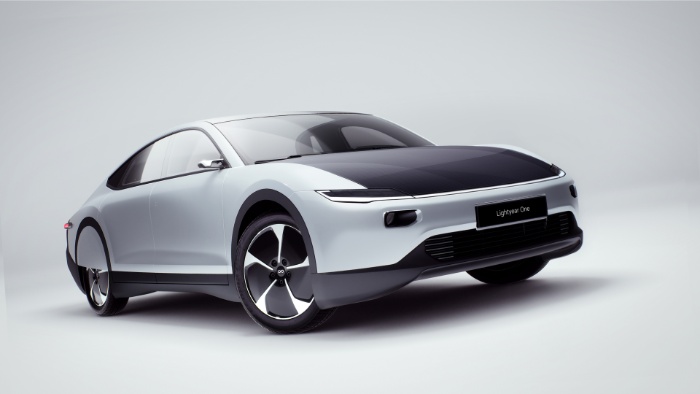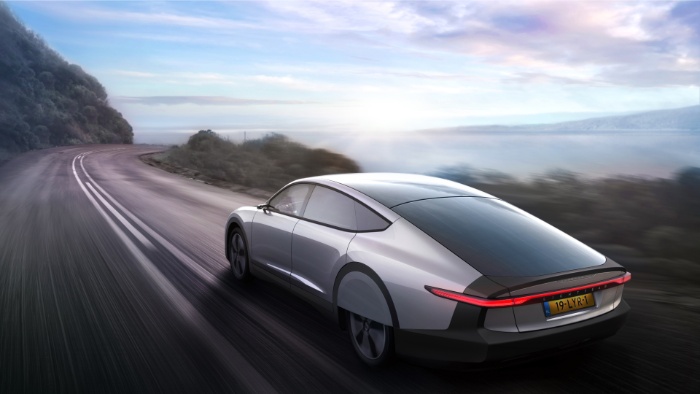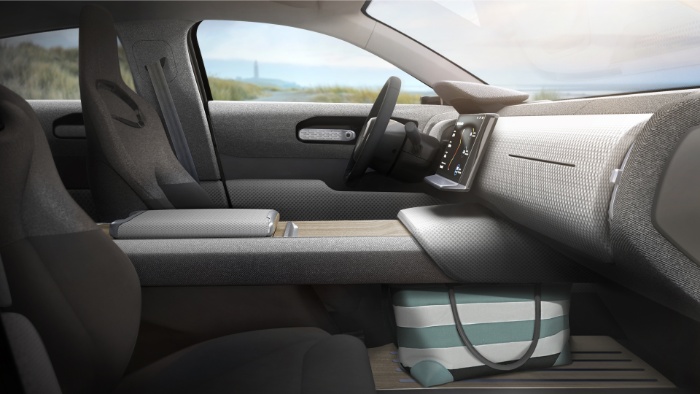Lightyear One is an electric, solar-powered vehicle, created by a team of graduates from the Eindhoven University of Technology in the Netherlands.
These guys are three-time winners of the World Solar Challenge where competing prototypes must drive 1,878 miles in the Australian outback on nothing but solar power.
Now, the team is working hard to put solar-powered cars on the road. Their Lightyear One prototype promises the longest EV range on the market, which can be extended or recharged via solar panels integrated into the top of the vehicle.
Solar-powered means free fuel
The solar panel stretches over an area of 54 sq ft, covering the entire top surface of the vehicle.

With a peak power output of 1.25 kW, it can recharge up to 7.45 miles of range per hour, regardless whether the vehicle is parked or moving.
Of course, this depends on how much sun you actually get:
- In sun-deprived Amsterdam, the car would recharge about 18.6 miles of travel per day during the summer.
- In sunny Los Angeles, it can easily generate 33 miles per day. Interestingly, this is also the average commute traveled by Americans on a typical day.

Obviously, you cannot rely on solar power alone, but it can comprise a significant portion of your energy. Check out the calculator on Lightyear’s website to see how the numbers change depending on your location and time of the year.
Lightyear guarantees the battery will last a minimum of 250 miles at highway speeds, with the AC on and during the winter. In optimal conditions, taking full advantage of the solar panels, the Lightyear One can travel up to 500 miles on a single charge.

That’s absolutely remarkable!
And, of course, you can plug it in at any conventional charging point, including the fast-charging stations and the domestic grid.
Efficiency is the name of the game
The core value of Lightyear is efficiency, which they frantically pursue in every aspect of their car.
It’s a classic example of “form follows function”. The body is sleek and futuristic but its shape and dimensions are chosen to provide the largest possible surface area for the solar panels while also minimizing aerodynamic drag.

In fact, the team claims the car has the smallest drag coefficient of any car on the market, though no number is posted.
Interestingly, Tesla claims the same with the Model S scoring an impressive 0.23 Cd.
The lower the number, the less wind resistance the vehicle experience, thus, it can travel longer with the same amount of energy. Audi engineers worked extensively on the aerodynamics of the e-Tron SUV in order to extend its range.
It’s impressive, but not for its speed
In a typical petrol-powered car, 10-20% of the engine’s power is used to turn the transmission, driveshaft, differential and CV joints, before the torque is finally delivered to the wheels.
Lightyear One effectively eliminates these parasitic losses by using wheel-integrated motors at all four corners. The motors themselves are designed for efficient power usage. Each one is controlled independently, allowing precise power delivery where it is needed.

The car will accelerate from 0 to 60 mph in 10 seconds. It’s not fast by any means, but perfectly capable of maintaining highway speeds.
A luxury 5-seater EV, built for practicality
The car is actually quite large with a footprint measuring 16.4 by 6.5 feet. It’s got four doors and will carry 5 people with plenty of leg room for everybody.

The fabric upholstery doesn’t look very impressive, but the car is designed for comfort, so perhaps it feels better to the touch than your economy class interior.
There is a large center console with a digital display, integrated rear-view camera and lots of space to empty out your pockets.
With the normal configuration and the rear seats up, you get 27.5 cu ft of cargo volume in the back. Folding the rear seats will open up a volume of 60 cu ft.

You can probably fit a mattress in there and go camping comfortably, with an unlimited power source keeping the AC on.
First customer cars are expected in 2021 and each will bear an eye-watering price tag – almost $170,000. Yes, that’s a whole lot, but innovation isn’t cheap. Luckily, there is plenty of interest.
The team is looking towards the future, putting solar energy into the hands of ordinary people. But, until the technology matures enough, it’s up to the wealthy enthusiasts to bear the cost.

